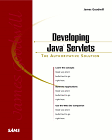Servlets are the way to go for developing e-commerce applications - at least it is what the book cover says.
And to learn about servlets we must read this book, or don't we? Let's see what we can learn from this book.
The book covers the Servlet 2.1 Development Kit.
The first two chapters cover the servlet architecture and how to configure a development environment for Java servlets.
The author shows how to setup such a development environment using Java WebServer and LiveSoftware's JRun.
In the third chapter the basics of the Servlet API are shown.
The parts that make up the servlet are explained.
The next chapter briefly explains how to get input from an HTML form field and how to use it in our servlets.
Next a simple HTML object library is built.
This library is used for examples in the remainder of the book.
The library is quit nice, but the subject of interaction between an HTML form with a servlet is too brief explained.
Chapter five covers server-side includes with Java servlets.
And the next chapter explains servlet chaining and how to use it with Java WebServer.
The seventh chapter is very practical and covers the use of servlets for saving state information on a server from for example an applet.
Because of applet limitations we cannot save information on the user's machine, but must redirect it to a server application.
Servlets are just the right thing and with good examples the author explains how to develop these servlets.
JDBC and servlets are the subject of the next chapter.
First we get a short introduction to JDBC and then example servlets show how to use JDBC with servlets.
The author also describes a connection pooling mechanism, which can be used to speed up performance.
Using the Objectstore PSE Pro database the author explain the development of servlets with object databases.
The first part of the chapter consists of an introduction to Objectstore PSE Pro.
The Java WebServer supports ServletBeans: servlets packaged in a JAR file.
ServletBeans are the subject of chapter ten.
A simple ServletBean is built and the deployment of the bean on Java WebServer is explained.
JavaServer Pages, JSP, is used for generating dynamic HTML pages on the server.
It is a combination of scripting and programming.
The chapter gives a short introduction to JSP.
To learn more about it we must look at the Java Server Pages Specification found at Sun's website.
Keeping track of a user or session information is the subject of the next chapter.
We have different solutions for tracking a user: from hidden fields to the servlet session support in Java servlets.
The author covers these different solutions.
Security is a very important part of applications on the Internet, especially for e-commerce applications.
And in chapter thirteen this subject is covered briefly.
A small example is shown and not all possibilities are explained.
Developing distributed applications in Java usually includes technologies like RMI and CORBA.
In the following chapter the author creates both RMI and CORBA servers and uses the servlets as clients to these servers.
It would have been nice to see an implementation of a RMI or CORBA server as a servlet, but it isn't shown in this book.
Finally in the last chapter a complete e-commerce application, a catalog application, is developed.
Two appendices conclude the book and in these appendices we can find a description of the Servlet API.
The book is written with developers in mind, but some of the chapters cover the subject to briefly to be useful.
Real-world examples and more examples are missing from chapters like security and server-side includes.
The author stays at the surface of subjects.
If you are just starting out writing Java servlets it can be a nice introduction, but you need a different book to start writing real servlets.
And if you already have been written Java servlets, you will not find anything new in this book.
(Hubert A. Klein Ikkink)




